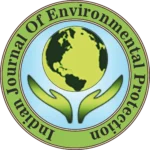IJEP 44(9): 825-832 : Vol. 44 Issue. 9 (September 2024)
Mihret Dananto and Kannan Narayanan*
Hawassa University Institute of Technology, Department of Water Resources and Irrigation Engineering, Hawassa, Sidama Region, Ethiopia
Abstract
Conventional drinking water treatments are often inappropriate in developing countries due to their high cost and availability of chemicals; hence, they are looking towards organic coagulants, like Moringa stenopetala. Laboratory experiments were carried out on the sampled water taken from Legedadi reservoir to assess the turbidity removal competence of Moringa stenopetala (MS) tree seed. Different concentrations of 50, 100, 150, 200, 250 and 300 mg/L were prepared from a 1000 mL of distilled water extract of Moringa stenopetala fine powder and applied to sampled water taken from Legedadi reservoir adjusted to different turbidity levels of 50, 200 and 400 NTU and to different pH level of 5, 6, 7, 8 and 9 using H2SO4 and NaOH (lime). The experiments showed that the highest turbidity removal was achieved at MS dosage of 150 mg/L (15 mL/L) for adjusted initial turbidity of 50 (94.1%) and 150 (98.8%) NTU and 200 mg/L (20 mL/L) for adjusted initial turbidity of 400 NTU (98.3%). Maximum turbidity removal occurred at neutral pH. Furthermore, the residual turbidity determined satisfied the WHO guidelines for drinking water (<5 NTU). The column experiment was accomplished for 94 min of detention time which gave the average overall removal efficiency of 77.7%. In general, water treatment with Moringa stenopetala tree seed powder is competent in removing impurities from turbid water but calls for detailed and rigorous scientific study on Moringa stenopetala in order to fully understand the characteristics of the plant and exploit its full potential for further recommendation in water treatment.
Keywords
Water treatment, Moringa stenopetala, Biological coagulant, Flood water, Jar test
References
- Becaria, A., A. Campbell and S.C. Bondy. 2002. Aluminium as a toxicant. Toxicol. Ind. Health. 18(7): 309-320.
- Davis. 2007. Alzheimer’s disease. Microsoft® Student 2007 [DVD]. Microsoft Corporation, Redmond, WA 2006. GenStat (2008). Gen Stat for Windows. Release 4.23DE.
- Katayon, S.S.C., et al. 2006. Preservation of coagulation efficiency of Moringa oleifera, a natural coagulant. Biotech. bioprocess eng., 11: 489-
495. - Abiyu, A., et al. 2018. Wastewater treatment potential of Moringa stenopetala over Moringa olifera as a natural coagulant, antimicrobial agent and heavy metal removals. Cogent Env. Sci., 4: 1433507
- Seifu, Eyassu. 2014. Actual and potential applications of Moringa stenopetala, underutilized indigenous vegetable of Southern Ethiopia: A review. Int. J. Agric. Food Res., 3(4): 8-19.
- Taiwo, A.S., A. Kuku and A. Okoya. 2020. Efficacy of a natural coagulant protein from Moringa oleifera (Lam) seeds in treatment of Opa reservoir water, Ile-Ife, Nigeria. Heliyon. 6(1): e03335.
- Ravikumar, K. and A.K. Sheeja. 2013. Fluoride removal from water using Moringa oleifera seed coagulation and double filtration. Int. J. Sci. Eng. Res., 4(8).
- Awad, M., H. Wang and L. Fengting. 2013. Weakness of Moringa oleifera use in water treatment. Int. J. Current Res., 5(5):1165-1167.
- Megersa, M., et al. 2019. Comparison of purified and crude extracted coagulants from plant species for turbidity removal. Int. J. Env. Sci. Tech., 16(5): 2333–2342.
- WHO. 2006. Improved sanitation facilities and drinking-water sources. World Health Organization, Geneva.
- Nkurunziza, T., et al. 2009. The effect of turbidity levels and Moringa oleifera concentration on the effectiveness of coagulation in water treatment. Water Sci. Tech., 59(8): 1551-1558.
- Hendrawati, I.R., et al. 2016. The use of Moringa oleifera seed powder as coagulant to improve the quality of wastewater and groundwater. Earth Env. Sci., 31: 1-10.
- Mataka, L.M., et al. 2006. Lead remediation of contaminated water using Moringa stenopetala and Moringa oleifera seed powder. Int. J. Env. Sci. Tech., 3: 131–139.
- Ndabigengesere, A., K.S. Narasiah and B.G. Talbot. 1995. Active agents and mechanism of coagulant of turbid waters using Moringa oleifera. Water Res., 29(2): 703–710.
